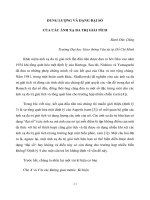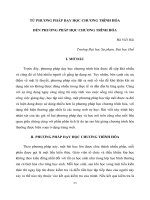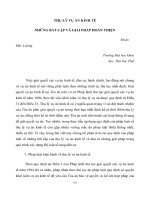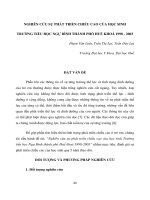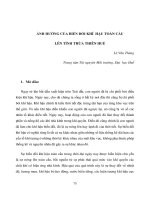Báo cáo nghiên cứu khoa học " PESTICIDES " doc
Bạn đang xem bản rút gọn của tài liệu. Xem và tải ngay bản đầy đủ của tài liệu tại đây (1.92 MB, 69 trang )
PESTICIDES
Tran Van Hai, Ph.D., Associate Professor
Plant Protection Department,
College of Agriculture & Biotechnology,
Can Tho University
A. INSECTICIDES
3.1. ORGANO-CHLOR GROUP
Chemical pesticides have been available after World War II.
- DDT is the first product.
- Other organo-chlor insecticides have been subsequently
produced.
They are composed of C, H, O, S… and Cl.
Advantages
- Simply produced
- Cheap
- Diverse formulations (soluble powder, emulsifiable
concentrate, dust, granular, etc.)
- Easily applied in field conditions
- Broad-spectrum, high and long-term effect
- Stable and therefore easily stored
- Easily degraded in basic condition
Disadvantages
- Long-term persistence in soil and plants
- Polluting environment
- In natural conditions, DDT totally degraded
within ten years.
- Persisting in food chains and residing mainly in
adipose tissues of animal and human bodies
- Having chronic toxicity and therefore causing
cancers, monstrosity, etc.
- Having high toxicity on fish and natural enemies
SOME ORGANO-CHLOR INSECTICIDES
COMMONLY USED IN THE PAST
1. DDT (Dichloro-diphenyl-trichloetan)
- Commercial products : DDT, GESAROL,
ZEDAN
- Common formulations: 30EC, 75WP, 10D,
5G, etc.
- Technical name: 1,1,1- Trichloro- 2,2 bis (p-
chlorophenyl) ethane
- Toxicity: LD50 (on mice) = 113mg/kg (the first
toxic class)
- Being banned
2. BHC
- Commercial names: LINDAFOR 90,
lindane, 6-6-6, HCH, etc.
- Common name: Benzen hexa chlorit
- Structural formula: C6H6Cl6
- Toxicity: LD50 = 125mg/kg (the first toxic
class)
- Being banned
3.ENDOSULFAN
- Commercial products: Thiodan 35EC, Thiodol
35EC, Tigiodan 35EC, Endosol 35EC,
Thasodan 35 EC
- Products are dark red in color and easily
degraded in basic condition.
- Having light toxicity on honey bees and some
natural enemies
- Having high toxicity on fish
- LD50 (on mice): 40-100mg/kg
- Commonly applied on corn, bean, cotton,
tobacco, and coffee
- Dosage: 350-500g ai/ha (1-1,5 l/ha)
-Thiodan belongs to the first toxic class. It is
reduced from use in Vietnam.
ACTION MECHANISM OF INSECTICIDES
Cruiser Plus tác động trực tiếp đến hệ thần kinh của bọ tró, đặc biệt là the post synaptic nerve.
Sodium Channel:
Pyrethroids
Acetylcholine esterase:
OP’s, Carbamates
Acetylcholine receptor:
Neonicotinoids
Pre-synapse
Post-synapse
Synaptic Cleft
Actara acts on signal receptor of the central
nervous system.
3.2. ORGANO-PHOSPHATE GROUP
- Composed of C, H, O, S… and P.
- Broad spectrum (effective on Coleoptera, Lepidoptera,
Homoptera, Orthoptera, Diptera,Hemynoptera and
Hemiptera, etc.)
- Mode of action: contact, oral and fumigation
- Persisting shortly in environment
- Rapid effect
- Having high acute toxicity due to fast accumulation and
strong effect on the nervous system
- Excreted via urination
- Atropine is one of the detoxicators.
- Having high toxicity on warm-blooded animals and natural
enemies
- Easily degraded in either acidic or basic condition
- Easily soluble in organic solvents but low in water
1. METHYL PARATHION
- Commercial names: Metaphos,
Wofatox, Folidon M, Metacid
- Common formulations: 50EC; 1.5D
- Toxicity: LD50 (on mice) = 25-50mg/kg
(the first toxic class)
- Methyl parathion is oxidized inside
insects to form Paraoxon which has
higher toxicity.
- Being banned
2. METHIDATHION ( Supracide 40EC,
Suprathion 40EC)
3.DIAZINON (Basudin 40EC, 50EC, 10H)
4. NALED (Dibrom 50EC, 96EC)
5. ENTHOPROPHOS, ETHOPROP
(Mocap 10G, NoKaph 10G, 20EC,
Vimoca 20EC)
6. DIMETHOATE (Bini 40EC, Bian
40EC, Bi58 40EC, Dithoate 40EC,
Tigithion 40EC)
7.ACEPHATE (Monster 40EC, 75WP;
Mytox 75SP; Orthene 97 Pellet)
8.DICHLOROVOS, DDVP (Demon
50EC): reduced from use
9.MONOCROTOPHOS (Azodrin 40DD,
Nuvacron 40SC, Magic 50SL, Apadrin
50SL) the first toxic class, being
banned
10.METHAMIDOPHOS (Monitor 50EC,
Filitox 70SC) the first toxic class,
being banned
3.3 CARBAMATE GROUP
- Structural formula: derivative of carbamic acid (NH2-
COOH)
- Narrow-spectrum, specific on sucking & chewing insects
- Mode of action: contact, oral and some of fumigation
- Persisting shortly in environment
- Rapid effect
- Having high acute toxicity due to fast accumulation and
strong effect on the nervous system
- Excreted via urination
- Atropine is one of the detoxicators.
- Having lighter toxicity on warm-blooded animals,
natural enemies and fish as compared to the organo-
phosphate insecticides.
- Easily degraded in either acidic or basic condition
- Easily soluble in organic solvents but low in water
1. CARBARYL
- Commercial products: Sevin 50 WP, 15 EC
- Stable under UV and high temperature
- Easily degraded in basic condition
- Toxicity: LD50 (on mice) = 560mg/kg
- Non-persistence in animals
- Usage: Sevin acts via surface contact or oral
entry. It is used with the concentration of 1-
3%o to control fruit-tree insects (Leaf folder,
Mealy bug, Scale, etc.), industrial-crop
insects (cotton, tobacco army worms.)
2. ISOPROCARB (MICP)
Mipcin 20 EC, Mipcide 20 EC, Vimipc 20EC,
Tigicarb 20EC, 20 WP
3.PHENOBUCARB (BPMC)
Bassa 50EC, Bassan 50EC, Bassatigi 50 EC,
Vibasa 50EC, Hopkill 50EC,
4.CARBOFURAN
Furadan 3G, Vifuran 3G, Kosfuran 3G
The first toxic class, reduced from use
5.METHOMYL
Lannate 40SP, Cofitex 24 SL
The first toxic class, reduced from use
3.4. SYNTHETIC PYRETHROIT GROUP
- Pyrethrin was extracted from Pyrethrum
cinerariaetrifolium in the 1960s.
- Broad spectrum: specific on chewing &
sucking insects, especially on larva of
Lepidoptera
- Mode of action: contact and oral, weak
effect by fumigation and non systemic
- Persisting shortly in environment and easily
degraded under sunlight and high
temperature
- Applied with much lower dosages as compared to
that of organo-chlor, organo-phosphate, and
carbamate insecticides
- Having weak acute toxicity
- Acting on the nervous system and causing oxygen
deficiency
- Excreted via urination
- Having light toxicity on warm-blooded animals
- Causing pest resistance rapidly in case of
uncontrolled use
- Easily soluble in organic solvents but low in water
1. CYPERMETHRIN
-Commercial products: Sherpa 10EC, 25EC,
Shertox 5EC, 10EC, 25EC, Sherbush 5EC,
10EC, 25EC, Shertox 5EC, 10EC, 25EC, ,
Southsher 5EC, 10EC, 25EC, Visher 25DC,
Cyperan 5EC, 10EC, 25EC, Cyperkill 5EC,
10EC, 25EC Cypermap 10EC, 25EC Cypersect
5EC, 10EC, Arrivo 5EC, 10EC
- Easily degraded in basic condition
- The second toxic class, LD50 per os: 215mg/kg
- Mode of action: contact and oral
- Used to control sucking insects, especially on
Lepidoptera such as chewing insects
- Dosage: 25-200g a.i/ha (depending on kind of
crops)
2. ALPHA CYPERMETHRIN
Fastac 5EC, Alpha 5 EC, Alphan 5 EC, Vifast 5 EC,
Cyper Alpha 4 ND
3. DELTAMETHRIN
Decis 2,5EC, Delta 2,5EC, Deltox 2,5EC, Appendelta 2,8
EC
4. CYHALOTHRIN
Karate 2,5EC, Vovinam 2,5EC, Sumo 2,5EC, FastKill
2,5EC.
5. FENPROPATHRIN
Danitol 10 EC, Vimite 10ND
6. FENVALERAT
Sumicidin 10EC, 20EC; Pyvalerate 20EC, Sanvalerate
20EC, Vifenva 20ND,
7. PERMETHRIN
Peran 10EC, 50EC, Perkill 50EC, PER Annong 100EC,
500EC, Ambush 50EC,Tigifast 10EC
3.5 BIO-INSECTICIDES
1. HORMONES
- Hormones are substances produced from
endocrines of living organisms to control their
physiological activities.
Hormone juvenin:
-Etofenprox (Trebon 10EC, 20EC, 30EC)
-Buprofezin (Applaud 25WP, 40SC, 2G)
-Telubenzuron (Nomolt 5SC)
-Chlorfluazuron (Atabron 5EC)
-Lufenuron (Match 50 EC)
-Tebufenozide (Mimic 20F)
2. PHEROMONES
- Pheromones are substances produced by insects
to form their inter-species relationship.
-Methyl eugenol which could attract fruit fly Dacus
dorsalis in fruit orchards
- Methyl eugenol 75% + Naled 25%: Ruvacon
90 L and Vizubon D for 2-3 traps/1.000m
2
- Methyl eugenol applied to remove male of fruit fly
in order to reduce density of current populations
- Advantages: highly selective ability, harmless to
environment, and preventing insect resistance
3. MICROBIAL INSECTICIDES
+ Fungal insecticides:
-Abamectin (Vertimec 1,8EC, Vibamec 1,8EC,
Abatimec 1,8EC, Nockout 1,8EC, Tap ky
1,8EC): Streptomyces avermitilis
-Spinosad (Success 25SC): Actinomycetes
-Beauveria bassiana: (Beauverin, Boverit
5x10
8
CFU )
-Metarhizium ansopliae: (Mat 5.5x10
8
spores/g)
Coconut beetles and larvae of armyworm
infected by Metarhizium anisopliae
+ Bacterial insecticides:
-Bt. is one of the bacterial insecticides produced from
Bacillus thuringiensis.
- Applied to control: Plutella xylostella, Trichoplusia
ni, Pieris brassicae, etc. It is also capable of
controlling insects which are less susceptible to Bt.
such as Spodoptera litura and Heliothis armigera
* Common bio-insecticides derived from Bacillus
thuringiensis:
-Bacillus thuringiensis var. kurstaki ( Biocin
16 WP, Dipel 6.4 WP, Forwabit 16 WP, Thuricide HP,
MVP 10FS)
-Bacillus thuringiensis var. aizawai (Aztron 7000
DBMU, Bathurin 3-5xIO9, Xentari 35 WDG)
Action mechanism of Bt.
Bacillus thuringiensis
Cry
Parasporal body
δ -endotoxin
Spore
M ode of action of Bacillus thuringiensis
Ingestion Producing
activated toxin
Columnar cell
Cells are swollen
Bacillus thuringiensis
Specific
binding
site
Cry toxin
Crystal toxin of Bt.


